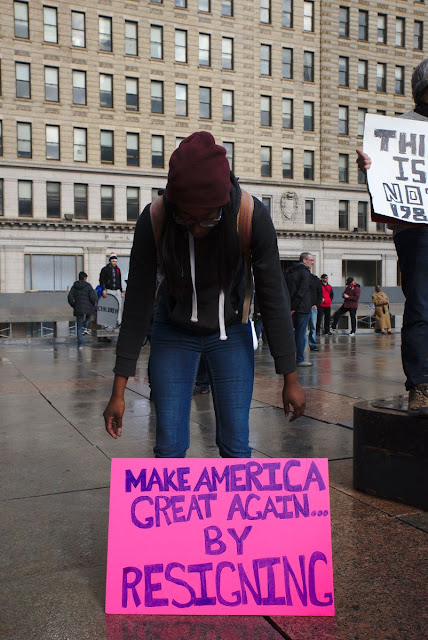In 2016 photography re-emerged as a reflective, creative discipline for me. Often art-making marked transitional phases in my life. This year, though, I turned toward photography as a serious central occupation thanks to many people in my life who gave intentional input and support to the artistic-creative identity I carry.
 |
| Photo by Kaytee Ray-Riek during a photo-fun session. |
7As I review the images taken throughout this year, I see my self moving from a simple documentarian with little or basic attention to craft, to an experimentalist of form, technique, story telling and equipment.
I began frustrated with my Samsung Galaxy smart phone camera. It operates poorly in low light, is slow to focus and gives little to no control over depth of field. Even with these constraints I explored. I purchased one of those low-cost lens attachments that give an even wider field of view - fisheye - that produced horrendously soft and blurry images, but provided a creative outlet.
 |
| Samsung Galaxy camera phone with "fish-eye" attachment. |
 |
| Samsung Galaxy camera phone with "fish-eye" attachment. |
 |
| Samsung Galaxy camera phone with "fish-eye" attachment. |
I eventually ditched this approach for my now-ancient Panasonc G2, an early micro-4/3rds digital camera that used interchangeable lenses and had been with me since Cambodia. It's out-of-the-box 14-42 zoom lens (with 2x crop factor) was always frustrating to me. It also performed terribly in low light, was slow to focus and produced high ISO noise above ISO 400. I planned to move on. It was time to get a "real photographers camera".
 |
| Panasonic G2. 14mm (28mm full-frame equivalent). |
This meant purchasing a Canon Rebel XT for $40 through craigslist. It was a roundabout way of making use of a Canon 70-300mm zoom lens attached to the Panasonic via an adapter ring. It allowed for greater creative outlet, and that was about it. The lens + Panasonic contraption was difficult to balance, made no use of autofocus or the ability to control aperture on the fly. To control aperture I'd connect the lens to the XT, manually change the aperture then reattach it to the Panasonic. It was an arcane, slow and necessary step forward, that simultaneously appealed to the hacker/maker in me.
My goal was to keep photography as cheap as possible. Purchasing a Panasonic zoom lens would've cost $300 or so. At the time it seemed completely out of the question. The canon zoom lens cost $80. The rebel XT $40 and the lens adapter something like $20. So for half the price I had my zoom lens sans autofocus or direct aperture control. Well, I was prepared for that. I "grew up" with a manual SLR camera. So I knew what I was getting into.
 |
| Canon Rebel XT with 70-300mm lens. |
In any case, this setup soon became frustrating. I started using the lens on the XT, which was a minor step up, certainly in usability. I wanted more, of course. So I did my online homework homework and settled on purchasing a used Canon T3i for $200. It promised to be newer, faster and more capable (by comparison). I now felt securely in the DSLR club, albeit at the bottom rung.
 |
| July 2016. Canon Rebel T3i. 50mm. |
Buying and selling on Ebay and Amazon proved a cost-effective way of liquidating assests and purchasing camera equipment. I sold the Panasonic G2, the 30-700mm zoom and the Rebel XT and with that money I bought the newest "kit" lenses I could afford (second hand, of course). My set-up now included a 50mm prime lens, an 18-55mm IS II STM zoom and a 55-200mm IS II STM zoom. These three lenses have expanded my ability to shoot digital photographs, with something for pretty much every circumstance.
Having settled on a camera system (for now) I have been released to create images. Some of them you've no doubt seen.
My favourite focal length has turned out to be 18mm (that's roughly 28mm full-frame equivalent). It makes for useful for capturing glorious sunrises and landscapes as well as emotionally vibrant street photography. I was trawling YouTube for learning content (it's free ya' know!) and came across Eric Kim's lessons on street photography. Probably the best advice I've received is to (mostly) ditch the long zoom lens and get up close and personal with a short focal length. It gets me right into the action. I have to be in the subjects' personal space or else they disappear into the background. In fact, many a person has taken a step backwards for fear my lens would impact with a facial feature.
 |
| Canon T3i. 18mm. To get this shot I was just a few inches behind this man's shoulder. |
 |
| Canon T3i. 18mm. |
 |
| Canon T3i. 18mm. |
Stay tuned for more 2016 retrospective blog articles.



























































